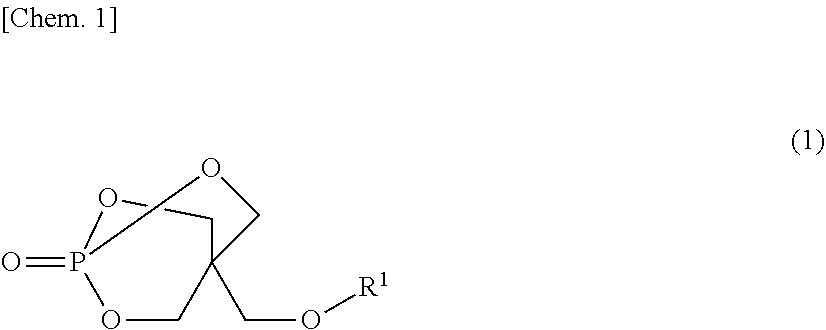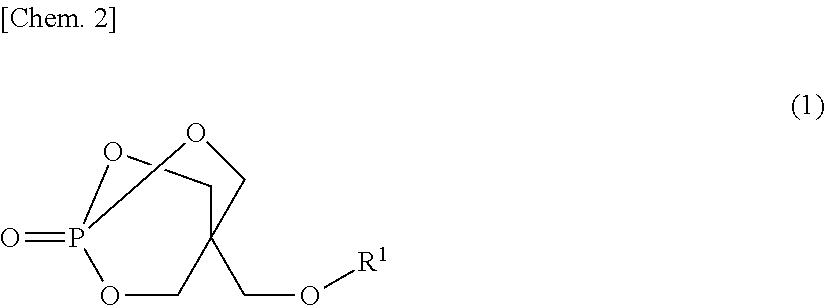Flame-retardant composition and flame-retardant synthetic-resin composition
a synthetic resin and flame retardant technology, applied in the direction of fireproof paints, etc., can solve the problems of resin discoloration, insufficient flame retardance of conventional flame retardants, and poor dispersibility of flame retardants
Inactive Publication Date: 2019-08-22
ADEKA CORP
View PDF0 Cites 2 Cited by
- Summary
- Abstract
- Description
- Claims
- Application Information
AI Technical Summary
Benefits of technology
The invention relates to a flame retardant composition that can be used in synthetic resins to prevent fire outbreaks. The composition contains a flame retardant and a lubricant, which helps to stabilize the resin. The lubricant can be a pure hydrocarbon lubricant or a combination of two or more therof. The composition can also contain a phenol antioxidant or a phosphorus antioxidant to further stabilize the resin. The amount of antioxidant added is preferably 0.1-10 parts by mass per 100 parts of the flame retardant composition.
Problems solved by technology
However, the conventional flame retardants have insufficient flame retardance and should be added in large quantities so as to obtain sufficient flame retardation.
When added in a large quantity, a flame retardant is poorly dispersible in synthetic resin matrix and necessitates an extended processing time or an elevated processing temperature, which results in heat application to a resin more than primarily necessary.
This can cause the resin to discolor.
Method used
the structure of the environmentally friendly knitted fabric provided by the present invention; figure 2 Flow chart of the yarn wrapping machine for environmentally friendly knitted fabrics and storage devices; image 3 Is the parameter map of the yarn covering machine
View moreImage
Smart Image Click on the blue labels to locate them in the text.
Smart ImageViewing Examples
Examples
Experimental program
Comparison scheme
Effect test
examples
[0080]The invention will now be illustrated in greater detail with reference to Examples, but the invention is not deemed to be limited thereto. The numerical values for formulations in Table 1 are in parts by mass, and those in Tables 2 and 3 are in mass percent.
the structure of the environmentally friendly knitted fabric provided by the present invention; figure 2 Flow chart of the yarn wrapping machine for environmentally friendly knitted fabrics and storage devices; image 3 Is the parameter map of the yarn covering machine
Login to View More PUM
| Property | Measurement | Unit |
|---|---|---|
| particle size | aaaaa | aaaaa |
| flame retardant | aaaaa | aaaaa |
| chemical | aaaaa | aaaaa |
Login to View More
Abstract
Disclosed is a flame-retardant synthetic resin composition containing: 20 to 50 parts by mass of at least one melamine salt selected from the group consisting of melamine orthophosphate, melamine pyrophosphate, and melamine polyphosphate (component (A)); 50 to 80 parts by mass of at least one piperazine salt selected from the group consisting of piperazine orthophosphate, piperazine pyrophosphate, and piperazine polyphosphate (component (B)), provided that the sum of components (A) and (B) is 100 parts by mass; and 1 to 50 parts by mass of a compound represented by general formula (1) (component (C)):wherein R1 represents an aliphatic or aromatic monocarboxylic acid residue.
Description
TECHNICAL FIELD[0001]This invention relates to a flame retardant composition and a flame-retardant synthetic resin composition containing the same.BACKGROUND ART[0002]Synthetic resins have been applied widely to constructional materials, automotive parts, packaging materials, agricultural materials, housings of appliances, toys, and so forth because of their excellent chemical and mechanical characteristics. However, most of synthetic resins are combustible and need to be rendered flame-retardant for some applications. It is well known that flame retardation is achieved by using halogen flame retardants, inorganic phosphorus flame retardants typified by red phosphorus and polyphosphoric acid compounds such as ammonium polyphosphates, organic phosphorus flame retardants typified by triarylphosphoric ester compounds, metal hydroxides, antimony oxide, which is a flame retardant synergist, and melamine compounds, either singly or in combinations thereof.[0003]In particular, an intumesce...
Claims
the structure of the environmentally friendly knitted fabric provided by the present invention; figure 2 Flow chart of the yarn wrapping machine for environmentally friendly knitted fabrics and storage devices; image 3 Is the parameter map of the yarn covering machine
Login to View More Application Information
Patent Timeline
 Login to View More
Login to View More Patent Type & Authority Applications(United States)
IPC IPC(8): C09K21/12C09K21/02C08K5/52C08K5/521C08K3/22C08K13/02
CPCC09K21/12C09K21/02C08K5/5205C08K5/521C08K3/22C08K13/02C08K2003/2296C08K2201/014C08K5/527C08L23/00C08L101/00C08L2201/02C08K5/34928C08L23/10C08K3/32
Inventor NI, YANGSAKURAI, HISASHISHIMIZU, TATSUYAYONEZAWA, YUTAKATANJI, NAOKO
Owner ADEKA CORP
Features
- R&D
- Intellectual Property
- Life Sciences
- Materials
- Tech Scout
Why Patsnap Eureka
- Unparalleled Data Quality
- Higher Quality Content
- 60% Fewer Hallucinations
Social media
Patsnap Eureka Blog
Learn More Browse by: Latest US Patents, China's latest patents, Technical Efficacy Thesaurus, Application Domain, Technology Topic, Popular Technical Reports.
© 2025 PatSnap. All rights reserved.Legal|Privacy policy|Modern Slavery Act Transparency Statement|Sitemap|About US| Contact US: help@patsnap.com



